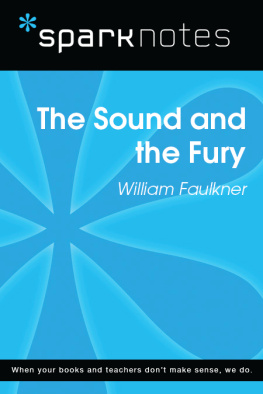The Sound and the Fury
William Faulkner
2003, 2007 by Spark Publishing
This Spark Publishing edition 2014 by SparkNotes LLC, an Affiliate of Barnes & Noble
All rights reserved. No part of this publication may be reproduced, stored in a retrieval system, or transmitted in any form or by any means (including electronic, mechanical, photocopying, recording, or otherwise) without prior written permission from the publisher.
Sparknotes is a registered trademark of SparkNotes LLC
Spark Publishing
A Division of Barnes & Noble
120 Fifth Avenue
New York, NY 10011
www.sparknotes.com /
ISBN-13: 978-1-4114-7774-2
Please submit changes or report errors to www.sparknotes.com/.
10 9 8 7 6 5 4 3 2 1
Context
W illiam Faulkner was born in 1897 in New Albany, Mississippi, to a prominent Southern family. A number of his ancestors were involved in the Mexican-American War, the Civil War, and the Reconstruction, and were part of the local railroad industry and political scene. Faulkner showed signs of artistic talent from a young age, but became bored with his classes and never finished high school.
Faulkner grew up in the town of Oxford, Mississippi, and eventually returned there in his later years and purchased his famous estate, Rowan Oak. Oxford and the surrounding area were Faulkners inspiration for the fictional Yoknapatawpha County, Mississippi, and its town of Jefferson. These locales became the setting for a number of his works. Faulkners Yoknapatawpha novels include The Sound and the Fury ( 1929 ), As I Lay Dying ( 1930 ), Light in August ( 1932 ), Absalom, Absalom! ( 1936 ), The Hamlet ( 1940 ), and Go Down, Moses ( 1942 ), and they feature some of the same characters and locations.
Faulkner was particularly interested in the decline of the Deep South after the Civil War. Many of his novels explore the deterioration of the Southern aristocracy after the destruction of its wealth and way of life during the Civil War and Reconstruction. Faulkner populates Yoknapatawpha County with the skeletons of old mansions and the ghosts of great men, patriarchs and generals from the past whose aristocratic families fail to live up to their historical greatness. Beneath the shadow of past grandeur, these families attempt to cling to old Southern values, codes, and myths that are corrupted and out of place in the reality of the modern world. The families in Faulkners novels are rife with failed sons, disgraced daughters, and smoldering resentments between whites and blacks in the aftermath of African-American slavery.
Faulkners reputation as one of the greatest novelists of the twentieth century is largely due to his highly experimental style. Faulkner was a pioneer in literary modernism, dramatically diverging from the forms and structures traditionally used in novels before his time. Faulkner often employs stream of consciousness narrative, discards any notion of chronological order, uses multiple narrators, shifts between the present and past tense, and tends toward impossibly long and complex sentences. Not surprisingly, these stylistic innovations make some of Faulkners novels incredibly challenging to the reader. However, these bold innovations paved the way for countless future writers to continue to experiment with the possibilities of the English language. For his efforts, Faulkner was awarded the Nobel Prize in Literature in 1949 . He died in Mississippi in 1962 .
First published in 1929 , The Sound and the Fury is recognized as one of the most successfully innovative and experimental American novels of its time, not to mention one of the most challenging to interpret. The novel concerns the downfall of the Compsons, who have been a prominent family in Jefferson, Mississippi, since before the Civil War. Faulkner represents the human experience by portraying events and images subjectively, through several different characters respective memories of childhood. The novels stream of consciousness style is frequently very opaque, as events are often deliberately obscured and narrated out of order. Despite its formidable complexity, The Sound and the Fury is an overpowering and deeply moving novel. It is generally regarded as Faulkners most important and remarkable literary work.
Plot Overview
A ttempting to apply traditional plot summary to The Sound and the Fury is difficult. At a basic level, the novel is about the three Compson brothers obsessions with the their sister Caddy, but this brief synopsis represents merely the surface of what the novel contains. A story told in four chapters, by four different voices, and out of chronological order, The Sound and the Fury requires intense concentration and patience to interpret and understand.
The first three chapters of the novel consist of the convoluted thoughts, voices, and memories of the three Compson brothers, captured on three different days. The brothers are Benjy, a severely retarded thirty-three-year-old man, speaking in April, 1928 ; Quentin, a young Harvard student, speaking in June, 1910 ; and Jason, a bitter farm-supply store worker, speaking again in April, 1928 . Faulkner tells the fourth chapter in his own narrative voice, but focuses on Dilsey, the Compson familys devoted Negro cook who has played a great part in raising the children. Faulkner harnesses the brothers memories of their sister Caddy, using a single symbolic moment to forecast the decline of the once prominent Compson family and to examine the deterioration of the Southern aristocratic class since the Civil War.
The Compsons are one of several prominent names in the town of Jefferson, Mississippi. Their ancestors helped settle the area and subsequently defended it during the Civil War. Since the war, the Compsons have gradually seen their wealth, land, and status crumble away. Mr. Compson is an alcoholic. Mrs. Compson is a self-absorbed hypochondriac who depends almost entirely upon Dilsey to raise her four children. Quentin, the oldest child, is a sensitive bundle of neuroses. Caddy is stubborn, but loving and compassionate. Jason has been difficult and mean-spirited since birth and is largely spurned by the other children. Benjy is severely mentally disabled, an idiot with no understanding of the concepts of time or morality. In the absence of the self-absorbed Mrs. Compson, Caddy serves as a mother figure and symbol of affection for Benjy and Quentin.
As the children grow older, however, Caddy begins to behave promiscuously, which torments Quentin and sends Benjy into fits of moaning and crying. Quentin is preparing to go to Harvard, and Mr. Compson sells a large portion of the family land to provide funds for the tuition. Caddy loses her virginity and becomes pregnant. She is unable or unwilling to name the father of the child, though it is likely Dalton Ames, a boy from town.
Caddys pregnancy leaves Quentin emotionally shattered. He attempts to claim false responsibility for the pregnancy, lying to his father that he and Caddy have committed incest. Mr. Compson is indifferent to Caddys promiscuity, dismissing Quentins story and telling his son to leave early for the Northeast.
Attempting to cover up her indiscretions, Caddy quickly marries Herbert Head, a banker she met in Indiana. Herbert promises Jason Compson a job in his bank. Herbert immediately divorces Caddy and rescinds Jasons job offer when he realizes his wife is pregnant with another mans child. Meanwhile, Quentin, still mired in despair over Caddys sin, commits suicide by drowning himself in the Charles River just before the end of his first year at Harvard.


















